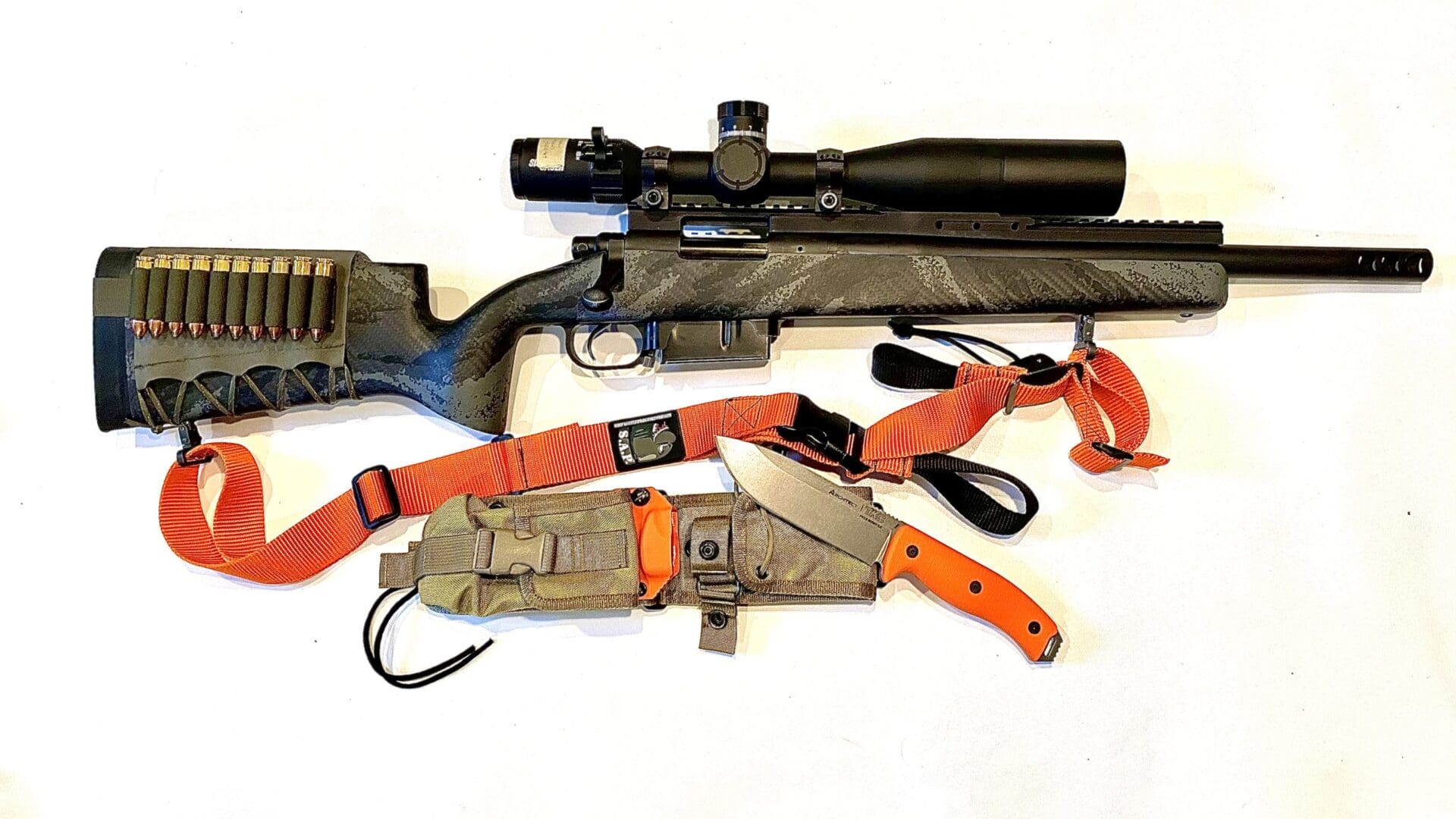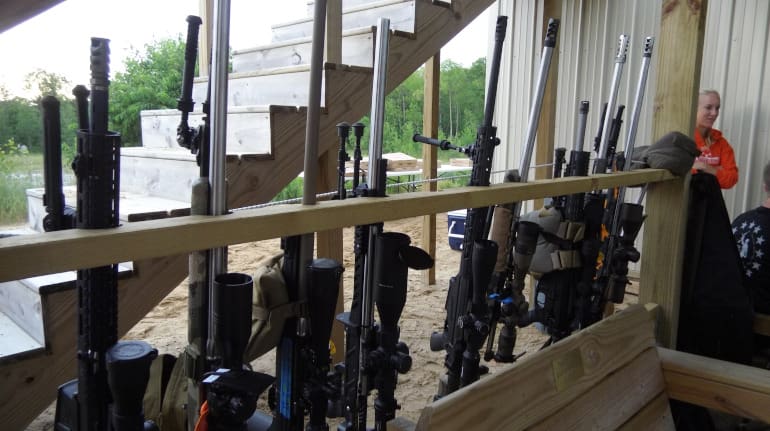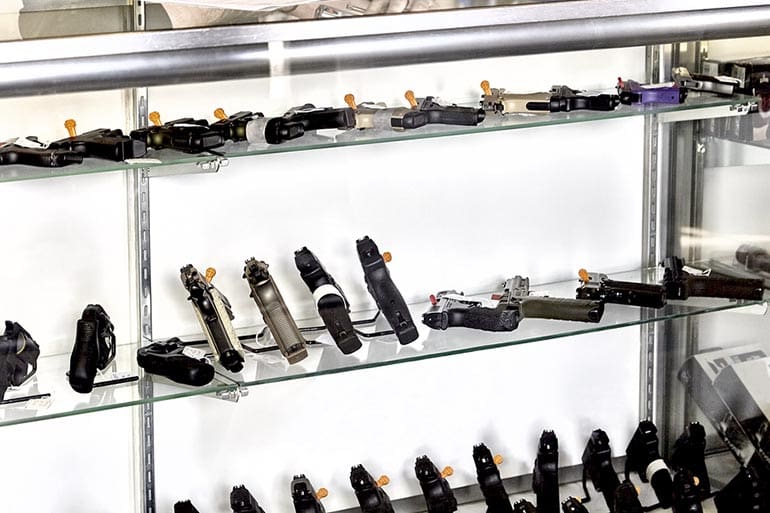Today’s Ask Josh comes from Dale R. Dale asks a reasonable question after seeing some of my guns . . .
“What makes carbon fiber parts so expensive. I see you like them, but are they worth it for me?”
Dale’s question is more complex than you may think. The carbon fiber parts in question today come in the form of stocks, barrels, handguards, and accessories. This list grows all the time.
The most common carbon fiber gun parts in general use are stocks and barrels. I have a couple of both and when combined they can make for a very light package. Weight reduction is an important feature of the material, however that’s not all it does.
In stocks carbon fiber makes for a far more rigid part, and thus more accurate, at least in theory. In barrels it increases rigidity while offering rapid heat dissipation, again theoretically improving accuracy.

There are a couple ways to look at what you get with these parts. In Dale’s case he was more interested in them for target shooting. Are carbon fiber barrels better than solid steel barrels? Maybe, but this degree of function is relative because many shooters who enjoy stationary target shooting actually prefer more weight. A carbon fiber barrel will shave more than half the weight off an identical-profile steel barrel.
A heavy benchrest rifle can be be fitted with a carbon fiber barrel, however it will probably be weighted down elsewhere to compensate. The carbon fiber’s function then becomes a matter of the rigidity and heat dissipation. I haven’t seen much benefit in terms of accuracy, but there are some people out there who say they do.

Carbon fiber parts don’t make much of an appearance in regulated rifle competition outside PRS-type events. Carbon fiber-wrapped AR barrels have been around for a long time now, but I don’t really see them being used much except in high-volume matches where weight reduction and heat dissipation are much bigger considerations than any accuracy improvement.
I’ve shot a number of carbon fiber barrels in both bolt guns and semi-autos and I have not noticed that the AR platform is distinctly more accurate with carbon fiber as opposed to a traditional target profile steel barrel.
I think that this has more to do with the design of the AR platform than anything else. I’ve shot and build more AR rifles than I can count and I have yet to find one that delivers the same overall consistency as a bolt action.
The gas tube and block assembly is always present on the AR and, despite extremely well-developed attempts, the system is never truly free floated like bolt actions. I haven’t seen carbon fiber AR barrels deliver better accuracy in real-world or match settings. Again, the greatest advantages with the use of carbon fiber in an AR come from rapid cooling and added stiffness while hot, thus reducing stringing after a few magazines.

It’s my opinion that bolt action rifles benefit the most from carbon fiber parts today. The AR is already a minimalist design and going with a carbon fiber setup only reduces weight by a relatively smaller amount. The AR is limited to its basic dimensions and can only have barrels that are an appropriate thickness to function with a gas block and barrel extension. A bolt action rifle can have just about as thick a barrel as you want as there is no gas function to worry about.
Traditional stocks and barrels on bolt guns are heavy and replacing existing units with carbon fiber versions saves a tremendous amount of weight. The weight reduction is less important for match shooters as it is hunters who strive for light weight and accuracy.
Carrying a rifle quickly becomes the opposite of fun if you have to do it for long enough over rough terrain and the weight reduction from carbon fiber results in a noticeable and welcome weight reduction.

The only downside is that the weight reduction comes with the inevitable increase in felt recoil. You can’t cheat Mr. Newton. This may not matter much on guns chambered in .308 or 6.5CM, but you’ll start to notice it more with .30-06, 7mm Mag, and .300 WinMag.
My 450 Bushmaster has an AG Composites stock and a steel barrel and action. That saves about 7 oz over a conventional stock, which isn’t much, but I like it for the fact that it’s weatherproof and isn’t sensitive to changes in temperature.
The weight reduction isn’t a big factor for me. The gun still weighs 9 lbs empty. I wanted a compact, highly rugged gun that offered the best in terms of real-world hunting, so this was a logical choice. Plus, with a little weight reduction I was able to add some more accessories and come out about even to what I used to have.
 I use two carbon fiber barrels on my 6.5 Creedmoors, one on a 16” with a carbon fiber stock and the other on a chassis rifle. The former I built for fun, the latter I prefer over my all-steel actions for medium range positional shooting out to 800 yards as well as some coyote hunting when I have spare time (which is almost never these days).
I use two carbon fiber barrels on my 6.5 Creedmoors, one on a 16” with a carbon fiber stock and the other on a chassis rifle. The former I built for fun, the latter I prefer over my all-steel actions for medium range positional shooting out to 800 yards as well as some coyote hunting when I have spare time (which is almost never these days).

If you decide to go for carbon fiber parts, realize that you’re not necessarily going to end up with a decidedly superior end result, but it will have different properties than an all-steel gun. I think stocks make the most difference for most people, with barrels less so.
In Dale’s case, he ended up deciding to not go with carbon fiber as he didn’t think his 200-yard game would be improved much by a $1,000 barrel over a steel one. I tend to agree with him and I think he made the right choice by sticking with steel for his applications.


![The Truth About: Hollow Point Bullets [Video]](https://dev.thetruthaboutguns.com/wp-content/uploads/2021/02/The-Truth-About-Hollow-Points-218x150.jpg)


I’m impressed in that Warner has assembled his words correctly and has delivered his information while avoiding the usual macho BS that is frequently found in current gun commentary.
I watched a dedicated bench rest shooter using a 6.5 Creedmore steel barrel, fluted, on a sled. What struck me was the amount of time he spent between each shot. I asked him about it and he said he let the barrel cool completely between rounds. Same hole accuracy on the target so I just said “wow”.
Bench rosters are an interesting bunch. O.C. To the max!
But by golly, they come up with fantastic results.
Yup. I am building a bench rest rifle and hope to match what I saw that guy doing. Not OC but I do like to punch the center at 100 yards.
Yep, seen the same thing- guy was literally making phone calls between shots on his RPR. When we checked the 100 yard targets his was just a big blank paper with a bunch of the 1″ black cover-up stickers on it- one hole in pretty much the center of each.
my first ar15 was a carbon 15 by bushmaster
got it for 600 brand new way back in the good old days when wal mart still sold ar15s
i liked it a lot
it came with a bushnell red dot and it was light af and was pretty accurate
only got rid of it because there werent any really good rail options for it at the time
i put a couple hundred worth goodies on it and ended up selling it to my local gun shop for what i originally paid for it
i used that money for my first ar build which i still have to this day
Interesting. My second AR is a Bushmaster Carbon 15. Same deal, came with that Bushnell Red Dot. The red dot was crap out of the box but the rifle has been a lot of fun. I was surprised too by its accuracy. I can hit clays at 100 yards repeatedly.
By no means a match or bench rest rifle, it’s a light weight plinker. Just a fun one with surprisingly good groups shooting Federal XM193.
Worked on Carbon Fiber Injection molded Nylon parts (33% CF – P/A 6/6) and found that when properly molded, almost match 1018 CR steel properties, at ~28% of the weight. These parts were DoD components, and were tested to failure. One application found that the CF Nylon parts actually were stronger (repeated flexing) than the 1018 CR.
Due to the rapid heat transfer from the Carbon Fibers, had to run the steel (Mold) temperature at 250`F. Easy to see if Mold is hot enough, as got a slick resin rich surface on molded parts when Mold was at correct temperature.
Most shops never run DSC testing, nor test to failure, of their molded parts. Too bad, as designed and molded properly, CF Nylon could replace machined steel for many applications. Think of a CF Nylon “Receiver/Stock”, with a steel barrel extension & barrel, rifle. The CF Nylon also absorbs the “recoil shock” when the rifle is shot.
Is it worth it?
Maybe, maybe not.
It might absolutely be worth it depending on the look and feel I want in my firearm. The form and function does matter if you like your guns.
Would be interesting to run a CF barrel for weight reduction, stiffness, and cooling advantages as a straight pull bolt action AR. I’ve done this with stainless barrels. First option as a selectable single shot bolt action/traditional semi-auto via adjustable ON/OFF gas block. Other approach as a bolt action only completely without gas block, gas tube, and bolt carrier gas key…..and even sans buffer/buffer spring (or use very minimalist buffer for spring force on carrier) and traditional charging handle assembly….for maximum weight reduction. Order an AR barrel without gas port drilled. A side charging upper receiver and bolt carrier, as from Alexander Arms or others, makes for a very convenient side charge straight pull action. Eliminating the gas system parts and action movement completely results in a true free float barrel AR for maximum accuracy equal to traditional non-AR bolt action. Makes for really long range accurate AR platform in 6MM ARC or .224 Valkyrie cartridges.or even 6.5 Grendel For about 800yds out, one can fire, run the straight pull action, and get back on target to spot the trace and impact to be one’s own spotter and make own adjustments. Makes one wonder why the Unitah bolt action approach requiring all the custom components and expense. What were they thinking….or NOT??!?!? Usually KISS principle is the best.
Well said.
Keep it simple, stupid.
Straight pull ARs rock. I have a straight pull AR pistol and it’s a beast in 450 Bushy. Eventually I may get around to doing a rifle but not yet.
I’ll trade more recoil for the lighter load on my back.
Yes, CF is worth it, but depends on your intention and use of the weapon and load out.
Been looking at .338 Lapua precision rifles. The one from Christensen Arms is much more light than Ruger, Savage and the other low budget rifles. I shoot some big stuff anyway so I doubt the .338 will beat me any more than my .375 H n Hs or .458 Win. I believe other than the old Win 59 12 ga, Christensen was about the first to market the CF-wrapped barrels.
THANK FOR NICE INFORMATION, VISIT OUR WEBSITE : https://telkomuniversity.ac.id/
Comments are closed.